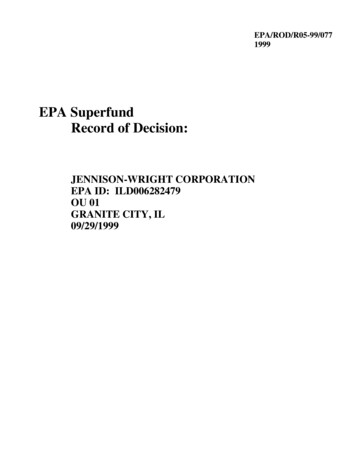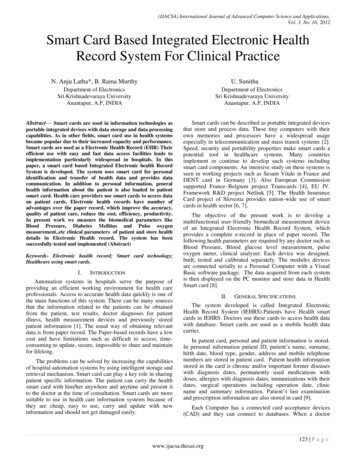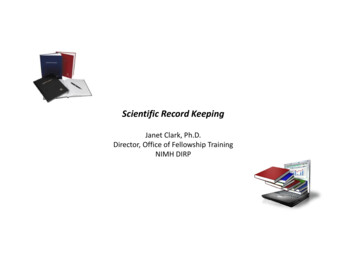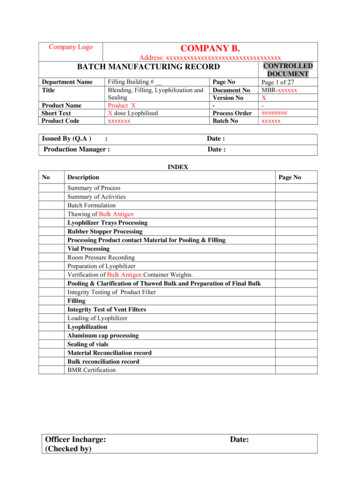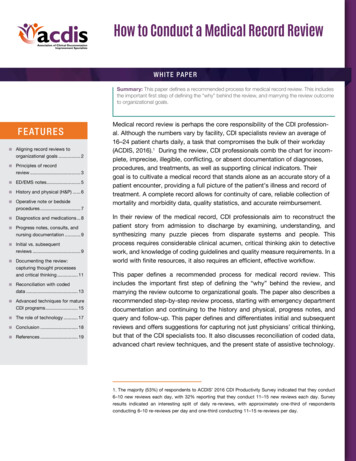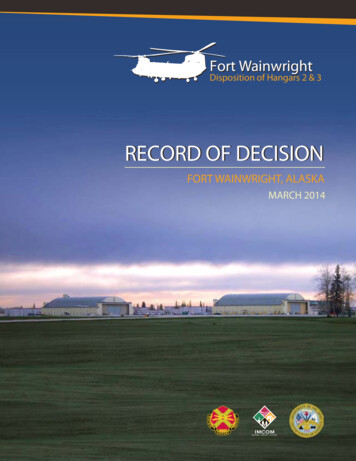
Transcription
Fort WainwrightDisposition of Hangars 2 & 3RECORD OF DECISIONFORT WAINWRIGHT, ALASKAMARCH 2014
Record of Decision for the Disposition of Hangars 2 and 3 at FortWainwright, AlaskaExecutive SummaryAs the Garrison Commander for the United States (U.S.) Army Garrison Fort Wainwright Alaska(USAG FWA), I have reviewed the Final Environmental Impact Statement (EIS)1 for the Disposition ofHangars 2 and 3 at Fort Wainwright, Alaska. The Final EIS adequately evaluates the potentialenvironmental effects associated with the proposed disposition of two historic World War II-erahangars, Hangars 2 and 3, at Fort Wainwright, Alaska. The Final EIS, published in January 2014, isincorporated by reference in this Record of Decision (ROD).The ROD explains that the U.S. Army (Army) will proceed with implementing its preferred alternative(Alternative 1, Demolition of Hangars 2 and 3). This alternative will involve removal of the hangarsand their supporting infrastructure, located on the Main Post of Fort Wainwright, Alaska. Bothbuildings have been found to be unsafe for occupancy and have no remaining military purpose. Thisdecision provides the proper balance of technical and economic feasibility, environmental and socialissues, and the ability to meet Army mission objectives, while eliminating the safety hazard presentedby Hangars 2 and 3.1.0BACKGROUNDHangars 2 and 3 are contributing resources to the Ladd Field National Historic Landmark (Ladd FieldNHL) and the Ladd Air Force Base Cold War Historic District (Cold War Historic District) on FortWainwright, Alaska. Constructed between 1943 and 1944 as semi-permanent structures, these hangarshave received varying degrees of operational maintenance over the years, but no large-scalerehabilitation has occurred. To accommodate changing missions, the Army completed numerousinterior modifications to the hangars, including creating doorways and windows and altering the interiorlateral cross-bracing. The lack of a large-scale rehabilitation and the numerous interior modifications,along with the age of the structures, a fire in Hangar 2 in early 2011, and the harsh Alaskanenvironment, have contributed to the compromised structural integrity of both hangars. The USAG1Because public and agency comments received on the Draft EIS during the public comment period for the Draft EIS did notresult in the modification of any of the alternatives or the environmental analysis in the Draft EIS, as allowed for in 40 Code ofFederal Regulations [CFR] §1503.4 and 32 CFR §651.45 (h), an Erratum to the Draft Environmental Impact Statement wasprepared. That document in conjunction with the Draft EIS is what constitutes the Final EIS for the Disposition of Hangars 2and 3 at Fort Wainwright, Alaska.1
Record of Decisionfor the Disposition of Hangars 2 and 3Fort Wainwright, AlaskaFWA condemned the buildings in 2011, and they are no longer used because of the safety hazard theypresent.The Final EIS evaluates the environmental effects of the Army’s proposal to determine a disposition forHangars 2 and 3 that will resolve safety and fiscal concerns and land use issues and comply withstatutory requirements. Determination of their disposition is needed to resolve the hangars’ inability tomeet the functional requirements as maintenance facilities for modern aircraft, to resolve their currentcondemned status that prevents them from serving an active military function at Fort Wainwright, andto resolve the safety hazard they present due to their compromised structural integrity. Additionally,through the winter of 2012 the hangars continued to be heated in the winter months to help preventsnow buildup on the roofs which, if left to accumulate, could collapse the structures. Maintaining theminimum heating (to avoid roof collapse and frozen pipes), electrical (to maintain indoor and outdoorlighting, fire suppression systems, pump mechanisms and equipment failure notifications), and water(to ensure fire suppression) requirements created annual utility costs for these unoccupied facilities ofapproximately 350,000 per hangar. Contributing to these high utility costs was the fact that thesehangars were not originally constructed with energy efficiency as a primary goal, and these high utilitycosts diverted operation and maintenance funds that could have been used for other priority projects onFort Wainwright.During the publication phase of the Final EIS, and after the document was signed by the ActingGarrison Commander, the USAG FWA was made aware of issues with the electrical and heatingsystems in Hangars 2 and 3. In late fall 2013 as winter approached, the Directorate of Public Works(DPW) began their annual maintenance on Hangars 2 and 3 to prepare them for the winter months (e.g.bring the heating systems back online). During these activities, it was discovered that much of themechanical equipment for the heating system in Hangar 3 had failed or was failing. Based on the unsafeworking conditions in and around the hangar, which is condemned, unoccupied, and continuing todeteriorate, as well as cost considerations, the decision was made not to repair or replace themechanical equipment. The mechanical equipment for the heating system in Hangar 2 was discoveredto be in even worse condition than in Hangar 3. It was also discovered that Doyon Utilities (the currentutility provider for the installation) had not reconnected Hangar 2 to the power grid after moving utilitypoles outside of the building in the summer of 2013. The utility poles were moved at the request of theUSAG FWA as part of a military construction project to widen Montgomery Road, which runs in frontof the hangars. Upon discovery of the failed systems and the lack of electricity to power the equipment,2
Record of Decisionfor the Disposition of Hangars 2 and 3Fort Wainwright, Alaskathe USAG FWA made the decision to not reconnect Hangar 2 to the power grid or repair/replace themechanical equipment for reasons similar to Hangar 3. With no heat currently being provided toHangars 2 or 3 to help prevent snow buildup on the roofs, the potential for an uncontrolled collapse ofthe hangars due to snow load has increased.The Final EIS and this ROD have been prepared in accordance with the National Environmental PolicyAct of 1969, as amended (NEPA) (42 United States Code [USC] §4321 et seq.); the Council onEnvironmental Quality (CEQ) regulations that implement NEPA (40 Code of Federal Regulations[CFR] §§1500-1508); and the Army’s NEPA-implementing regulation (32 CFR §651, EnvironmentalAnalysis of Army Actions). Additionally, because the hangars are contributing resources within the LaddField NHL and Cold War Historic District, the proposal to determine and implement a new dispositionfor Hangars 2 and 3 was considered an undertaking under the National Historic Preservation Act(NHPA) and required Section 106 consultation procedures of the NHPA to be followed.Given the new information concerning the failure of the electrical and heating systems in the hangars,the Army analyzed this change with regards to whether the Final EIS should be supplemented inaccordance with 32 CFR §651.45(l). This section states that “If there are substantial changes in theproposed action, or significant new information relevant to environmental concerns during the proposedaction's planning process, the proponent will prepare revisions or a supplement to any environmentaldocument or prepare new documentation as necessary.” The failure of the electrical and heatingsystems in the hangars is not a substantial change in the proposed action or significant new informationrelevant to environmental concerns. In the Final EIS, the description and analysis of the No ActionAlternative (Alternative 2) notes that as large structural systems fail they will not be replaced or receivemajor repairs and that this could contribute to an eventual uncontrolled collapse of the hangars. Becausethe failure of major systems in the hangars is already considered and analyzed in the Final EIS,supplementation of the Final EIS is not required.2.0PROPOSED ACTIONThe USAG FWA proposes to determine and implement a disposition for Hangars 2 and 3 andsupporting infrastructure located at Fort Wainwright, Alaska. Actions will be taken to avoid, minimize,or otherwise mitigate any adverse effects on historic properties.3
Record of Decisionfor the Disposition of Hangars 2 and 3Fort Wainwright, Alaska3.0ALTERNATIVESThe USAG FWA developed a screening process to evaluate reasonable alternatives and determine theirability to satisfy the purpose and need of the Proposed Action. The screening criteria for alternativesincluded 1) the action must directly address the disposition of Hangars 2 and 3, 2) the action must becompatible with the current and future military mission at Fort Wainwright, 3) the action must not beprohibitively expensive, and 4) the action must have a reasonably foreseeable funding source, or amechanism for obtaining applicable and timely funding to pay for life, health, and safety upgrades ordemolition actions. In order for an alternative to be considered reasonable for further analysis, it had tomeet all four screening criteria. After conducting a viability analysis of a range of alternatives based onthe screening criteria, USAG FWA determined that there was only one viable action alternative:demolition of Hangars 2 and 3 and conversion of the demolition footprint along the airfield to concreteapron. This, along with the No Action Alternative was carried forward for analysis in the EIS.These two alternatives for implementing the Proposed Action are discussed in Chapter 2.0 of the FinalEIS and are summarized here.3.1Alternative 1: Demolition of Hangars 2 and 3 (Preferred Alternative)Under this alternative, Hangars 2 and 3 and their supporting infrastructure will be demolishedbeginning in spring 2014. Demolition will involve removal of the hangars, totaling 24,016 cubic yardsof non-hazardous debris; demolition of existing and abandoned utilities not belonging to DoyonUtilities (the current utility provider for the installation), totaling approximately 2,680 linear feet;demolition of existing privately owned vehicle parking areas, lighting, head bolt outlets, and powersource, encompassing an area of approximately 3.3 acres; and demolition of the concrete building slabsand foundations within 5 feet of the building, to a depth of 8 inches, totaling approximately 2,075 cubicyards of debris. In addition, a small (200-square-foot), open, flammable liquids storage facility locatedbetween Hangars 2 and 3, which is currently empty, will be demolished, totaling approximately 91cubic yards of debris. Prior to demolition, the Army will conduct hazardous material surveys of thebuildings and their supporting infrastructure, including surveys for soil contamination. The Army willremove and dispose of any hazardous materials found. Asbestos-containing building materials (ACBM)will be disposed of in the Fort Wainwright landfill, while all other hazardous materials will be disposedof off-post in the Fairbanks North Star Borough (FNSB) landfill in accordance with applicable federaland state regulations. Non-hazardous demolition debris will be disposed of in the FNSB landfill;4
Record of Decisionfor the Disposition of Hangars 2 and 3Fort Wainwright, Alaskahowever, the Army will divert (i.e., salvage, recycle, or reuse) non-hazardous materials from beingplaced in the landfill to the maximum extent practicable.Once demolition of the hangars is complete, concrete will be added to the building and infrastructurefootprints to maintain consistency with the adjacent airfield, which is designated as an aircraft parkingapron. The Army will construct two asphalt access roads to the new apron to facilitate travel byemergency and maintenance vehicles. Infiltration areas, swales, and culverts for stormwater will beinstalled as needed, to include the addition of topsoil and seeding. Security fencing, compatible withexisting design, will also be installed. The total area encompassed by this project is approximately 10acres. Any future construction on this site is currently unknown and is beyond the scope of the EIS. Iffuture construction does occur, it would be the subject of separate NEPA documentation.3.2Alternative 2: No Action AlternativeUnder the No Action Alternative, demolition of Hangars 2 and 3 would not occur. While remainingintact, the hangars would continue to not meet the functional requirements of maintenance facilities foraircraft and would serve no active military function. The hangars would remain vacant because theyhave been found to be unsafe for occupancy. Maintenance and upkeep of the hangars, such as securitypatrols, pest control, and building systems maintenance, would continue based on current funding levelsand other maintenance priorities at Fort Wainwright; however, as large structural systems fail, theywould not be replaced or receive major repairs. For example, while the Army had planned to continueto heat the facilities to prevent snow buildup on the roofs (which, if allowed to accumulate, could causetheir collapse), the heating systems in both hangars became non-functional in the fall of 2013. As aresult of the unsafe working conditions in and around the hangars, as well as cost considerations, thedecision was made not to repair or replace the systems. Additionally, freezing and bursting of waterpipes in Hangar 2 in late 2012 rendered the fire suppression system within the side offices inoperable.Unsafe working conditions and current funding levels prevent this system from being repaired as well.Maintenance and upkeep of the hangars, including utilities, requires approximately 350,000 per hangarin annual funding. Given the current disrepair of the hangars, they present safety concerns for anyperson entering them, and in some cases, safety concerns prevent maintenance. Prior to theircondemnation in 2011, the following maintenance activities were performed: fire suppression sprinklermaintenance, oil-water separator maintenance, minor facility preventative maintenance, and project-byproject repair maintenance. All maintenance activities except fire suppression sprinkler maintenance5
Record of Decisionfor the Disposition of Hangars 2 and 3Fort Wainwright, Alaskawere halted following the determination that the hangars were unsafe for occupancy. Because there willbe no large-scale rehabilitation efforts and the likelihood that future system failure will not result inreplacement or repair, the structural integrity of the hangars will continue to deteriorate over time. Theeventual uncontrolled collapse of the buildings or perhaps the total loss of one or both hangars by fire,due to inoperable fire suppression systems, is likely. In addition, with the heating systems in bothhangars no longer functional and able to help prevent snow buildup on the roofs, the uncontrolledcollapse of the buildings due to snow load is now more likely than previously thought. At such time thebuildings do collapse, all debris would be treated as waste and disposed of in the FNSB landfill. Due tothe uncontrolled nature of the potential collapse, it is likely that the option for salvaging, recycling, orreusing building materials would be eliminated. Thus, the total amount of debris generated under theNo Action Alternative would likely be more than that generated under Alternative 1 due to the inabilityto divert materials from local landfills. Any follow-on actions associated with the location would besubject to funding, but the current preference would be that concrete is added to the building footprintsto maintain consistency with the adjacent airfield as an aircraft parking apron.3.3Alternatives Eliminated from Detailed ConsiderationAs discussed above, a range of alternatives were evaluated during the screening process to determinetheir ability to satisfy the purpose and need of the Proposed Action. The alternatives that did not meetall four screening criteria and thus were eliminated from detailed analysis in the EIS were: Demolition of either Hangar 2 or Hangar 3 and conversion of the demolition footprint along theairfield to concrete apron Rehabilitation of either Hangar 2 or Hangar 3 or both to support the following uses:a. Unmanned Aircraft System (UAS) maintenance hangarb. Aviation combined arms tactical trainer (AVCATT) simulator trainingc. Fixed simulator trainingd. Physical fitness center/gymnasiume. Arctic readiness center/fieldhousef.General purpose warm storageg. Youth centerh. Museumi.Roller rink6
Record of Decisionfor the Disposition of Hangars 2 and 3Fort Wainwright, Alaska Removal and reconstruction of either Hangar 2 or Hangar 3 or both on Fort Wainwright tosupport the following uses:a. UAS maintenance hangarb. AVCATT simulator trainingc. Fixed simulator trainingd. Physical fitness center/gymnasiume. Arctic readiness center/fieldhousef.General purpose warm storageg. Youth centerh. Museumi. Roller rinkClosed layaway of either Hangar 2 or Hangar 3 or both (i.e., hangars would be rehabilitated toensure their long-term structural integrity, but they would remain permanently closed/vacant) Transfer of ownership of either Hangar 2 or Hangar 3 or both to the following non-Armyentities:a. Federalb. Statec. Private/commercial4.0PUBLIC, AGENCY, AND TRIBAL INVOLVEMENTIn accordance with CEQ regulations (40 CFR §1500-1508) and the Army’s NEPA-implementingregulations (32 CFR §651), the Army provided federal, state, and local agency stakeholders, the public,Alaska Native tribes, and other interested parties the following notifications and opportunities forinvolvement during preparation of the EIS: A Notice of Intent (NOI) to prepare an EIS was published in the Federal Register on November16, 2011. Publication of the NOI began a 63-day scoping period from November 16, 2011, toJanuary 17, 2012. The Army also published an Open House Public Meeting notice in theFairbanks Daily News-Miner on November 11 and 16, 2011, and on December 4, 7, 11, and 14,2011.7
Record of Decisionfor the Disposition of Hangars 2 and 3Fort Wainwright, Alaska As part of the scoping process, the USAG FWA held a public scoping meeting on December14, 2011, at the Noel Wien Public Library in Fairbanks, Alaska. A separate agency scopingmeeting was held on December 15, 2011, to inform agencies of the Proposed Action and tosolicit input on the potential alternatives and areas of concern. The EIS considered andaddressed each comment received during the scoping process. Because the Army’s Proposed Action would involve potential adverse impacts to the LaddField NHL, in October 2011, the USAG FWA invited the National Park Service (NPS), theAdvisory Council on Historic Preservation (ACHP), and the Alaska State Historic PreservationOffice (SHPO) to become cooperating agencies for this EIS. Both the NPS and the ACHPdeclined the invitation, and no response was received from the Alaska SHPO; however, allthree agencies participated in the NEPA process and were consulting parties in the NHPASection 106 process. The USAG FWA consulted with Alaska Native tribes in accordance with the requirements ofDepartment of Defense (DoD) Instruction 4710.02, DoD Interactions with Federallyrecognized Tribes; Executive Order 13175, Consultation and Coordination with Indian TribalGovernments; the DoD American Indian and Alaska Native Policy and Alaska ImplementationGuidance; and the Department of the Army American Indian and Alaska Native Policy. Sixfederally recognized tribes were sent letters notifying them of the Army’s intent to prepare anEIS and informing them about the public scoping meeting times and locations. The tribes wereoffered the opportunity to enter into government-to-government consultation and to becomeconsulting parties to the NHPA Section 106 process. The letters were followed up with emails,telephone calls, and faxes, respective of the tribes’ wishes for mode of communication.
Garrison Commander, the USAG FWA was made aware of issues with the electrical and heating systems in Hangars 2 and 3. In late fall 2013 as winter approached, the Directorate of Public Works (DPW) began their annual maintenance on Hangars 2 and 3 to prepare them for the winter months (e.g.

